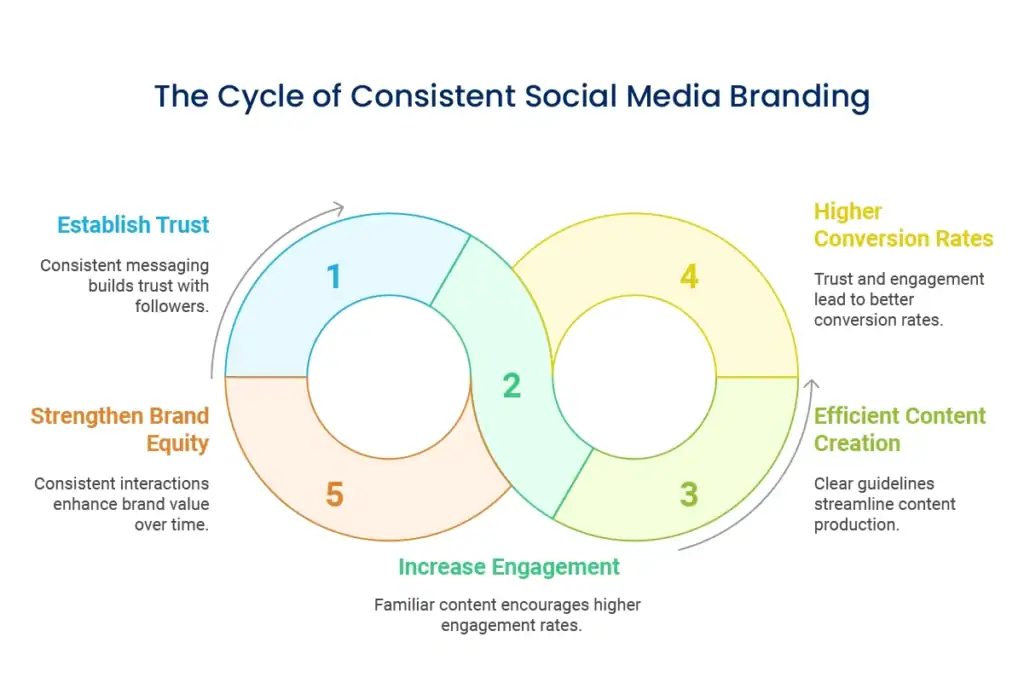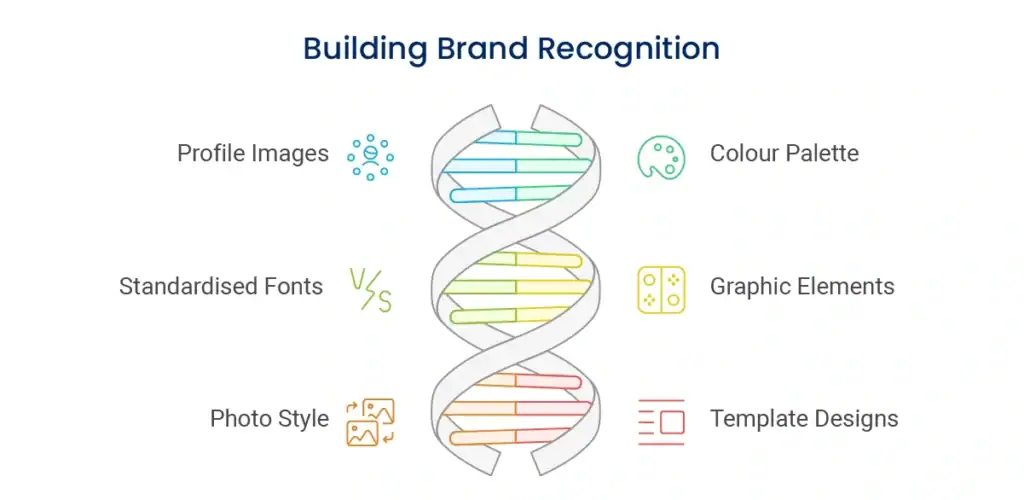Our Core Services
Are your social updates feeling scattered and unrelated, yet you’re posting all the time? Many companies grapple with this same problem—posting content that seems to be coming from various firms instead of one cohesive brand. Social media brand consistency is not only about having the same logo everywhere; it’s purposeful alignment of each post, comment, and story with your fundamental brand identity. When executed correctly, this consistency refines disjointed content into a strong business asset that gains recognition and trust.
This page dissects exactly how to build a consistent social media brand presence that speaks to your audience and aligns with your overall marketing objectives. We’ll take you through everything from establishing your social identity to utilizing functional systems that are consistent without losing creativity.


Social media brand consistency means showcasing your brand using the same voice, values, visual, and messaging throughout all social channels, while learning to adapt to the changing environment of each channel. It’s the process of creating a uniform and consistent presence across audience eyes that can be recognized quickly as yours, no matter if they’re looking at Instagram, LinkedIn, or TikTok.
In contrast to random posting, where content is disconnected and appears to be made up on the spot, a social media brand strategy is one in which each item of content complements the others to build your brand identity. It’s like writing one single story through many little chapters instead of releasing standalone short stories that leave readers uncertain about who you are.
For startups and small businesses in particular, this consistency acts as an amplifier of effect, getting your limited resources to work that much harder by adding on to earlier impressions and not starting over from scratch with every new entry.

Creating a consistent social brand is not merely being professional-looking—it has quantifiable business advantages that impact your bottom line directly:
When fans experience consistent messaging and visuals, they form quicker recognition and stronger trust for your brand. Through studies, consistent brands are 3.5 times more likely to experience superb visibility for their brand when compared with inconsistent ones.
Consistency creates trust in your products or services. Companies with consistent social media branding experience conversion rates that are around 20% higher than companies whose approaches lack consistency.
Viewers are more easily engaged by content that's familiar but new. Brands with stable social media personas enjoy up to 33% higher engagement compared to brands with inconsistent strategies.
With defined rules, your team invests less time arguing over what's "on-brand" and more time crafting effective content. This can cut content creation time by up to 40%.
For small businesses pitted against larger entities with greater budgets, consistency can be the great leveller that allows you to punch above your weight division in perceived professionalism and dependability.
Your social media brand identity must have a good architecture before posting. This architecture consists of your values, mission, personality, and positioning. These determine all the content you post.
The most effective brands initially define their “why”—the mission that motivates them beyond profit. This mission serves as the guiding star for every social content choice. If, for instance, your brand is about environmental stewardship, this underlying belief must shine through in your content decisions, from featuring green practices to recognizing Earth Day.
Your brand identity structure also defines your visual direction, enabling you to choose colors, typeface, and design elements that reflect your personality. A humorous brand can have energetic colors and relaxed fonts, whereas a high-end professional service can have muted tones and sophisticated typography.
Your brand voice is how your personality shines in writing—whether formal, conversational, humorous, or inspirational. A well-defined messaging framework guarantees this voice is consistent no matter who produces the content.
This structure encompasses your run-of-the-mill greetings, sign-offs, and catchphrases, as well as how you handle different scenarios. For example, how does your business respond to customer complaints versus birthday wishes? Having those responses pre-mapped ensures consistency even for off-the-cuff interactions.
How you format your content also comes under this paradigm—whether you’re usually writing in short, punchy statements or longer descriptions. The consistency of this structure enables audiences to recognize your content at once as they scroll through their timelines.

Visual consistency builds immediate recognition before people even read your content. A solid visual identity system for social media consists of:
When your followers glance at your unique visual voice, they must immediately recognize your brand—whether or not they see your logo. This visual shorthand is more and more precious as people rapidly scroll through content-dense feeds.

Content pillars are the 3-5 central topics that your social media content is based on. They provide variety without losing sight of relevance to your brand image and audience interests.
For instance, a fitness brand may have content pillars such as tips for working out, nutrition, success stories, and mindset coaching. Each pillar aligns with the overall mission of the brand but addresses various sides of the customer journey.
These columns keep random posting at bay by providing your team with clear guidelines for content development while still allowing room for creativity within the parameters. They also enable you to keep your content in balance and not focus too much on a single area of your business.
While consistency is key, so too is recognizing the distinctive environment of each platform and responding accordingly. This is not about having a separate brand for every platform, but rather communicating your consistent brand in platform-friendly manners.
For example, your content on LinkedIn could be more formal in tone but still address the same topics that you discuss on Instagram, albeit with a less formal tone. Your visual identity components stay the same but execute differently to fit audience expectations on each platform.
Strong brands uphold their fundamental character while managing their content format, length, and tone to adapt to the way people engage with various platforms—without losing what makes them identifiable.

Start by taking an audit of your current social presence on all sites. Check for discrepancies in visual aspects, tone of messaging, type of content, and general impression. Ask yourself:
Document these findings to document gaps between your desired brand presentation and your current reality.
Develop an in-depth document that sets out every element of your social media brand presentation:
These guidelines should be thorough enough to offer definitive direction but loose enough to enable creativity. Share them with all parties involved in your social media content development and management.
Pin down 3-5 core content themes that complement both your brand values and the interests of your audience. For each pillar:
This system avoids random posting by making sure all content further strengthens your overall strategy and presents sufficient variety so that it doesn’t fall flat with your audience.
Create a library of templates for various content types that are visually consistent but enable new content:
These templates should include your brand colors, fonts, and design elements while being versatile enough to support varying content requirements. Think about building platform-specific variations that take into account differing dimension requirements.
Create a strategic posting rhythm that balances your content pillars and is consistent:
This calendar strategy avoids last-minute scrambling that tends to create inconsistent, off-brand postings and guarantees a balanced blend of content types.
Make sure all the people who touch your social media know how crucial it is to have brand consistency:
Even if you’re a solo entrepreneur, write down these standards for yourself and any future employees or freelancers who may assist your social media.
Set up metrics to measure the effect of your consistency efforts:
Monitor these metrics regularly to see what’s effective and what requires tweaking, while keeping your core brand consistency intact.
Finally, have a process in place for growing your social media brand presence without sacrificing consistency:
This procedure allows your social media brand to grow organically while keeping the consistency necessary for creating recognition and trust.
Platforms such as Sprout Social enable monitoring of brand sentiment and engagement across social media channels and offer useful information regarding how your consistency efforts are doing. With metrics such as brand mentions, engagement rates, and audience growth to monitor, you can see where your consistency may be lagging or where it is having a particularly beneficial impact.
Canva is a great place to store and create brand templates, so your team always has access to on-brand assets. With its brand kit option, you can store your logos, fonts, and colours and apply them instantly to any piece of design. This centred approach stops the issue of inconsistent or outdated assets being used in smaller teams.
Content calendar software such as Trello or Asana also assist in keeping your content pillar mix and posting frequency in balance. These programs enable you to see your content mix on different platforms and verify that you're introducing variety while being consistent with your brand themes. The option to tag guidelines to types of content assists in keeping consistency even if there are several team members.
Tools such as Hootsuite or Buffer offer approval workflows and scheduling that can reinforce consistency. With these tools, you can schedule your content ahead of time, check it for brand fit, and maintain regular posting schedules—all essential components to keeping your social media presence cohesive.

Avoid these pitfalls that frequently undermine social media brand consistency efforts:
Most brands develop completely different personas across networks rather than projecting their basic identity into each platform’s setting. This results in a fractured brand experience when followers meet you on several networks.
Solution: Keep your core values and brand voice intact and only modify the format and some of the execution specifics for each channel. Your Instagram and LinkedIn accounts should look and sound like the same brand talking in two different settings, not like two different brands altogether.
Hopping on every popular topic or platform trend without regard for brand fit creates incoherent content that confuses your audience about your values.
Solution: Run trends through your brand values and content pillars. Only engage in trends that you can genuinely tie to your brand purpose and voice. This strategic selectivity creates a more integrated brand story than trying to be included in every conversation.
Too strict guidelines will result in dull, stilted writing that does not capture your audience’s attention, no matter how consistent.
Solution: Make your guidelines more about the “why” of your rules than the rules themselves. Create room for flexibility within boundaries, and inspire imaginative interpretation of your brand elements while holding fast to main consistency tenets.
Most brands emphasize post consistency but not that comments, responses, and interactions with the community are just as significant brand touchpoints.
Solution: Have response guidelines as part of your social media brand plan, including sample responses for various types of interactions in a way that keeps your brand voice. Educate all staff members who could respond to messages or comments on these standards.
Social media brand consistency turns disjointed posts into an effective brand-building system. By crafting definitive guidelines, strategic content pillars, and streamlined workflows, you turn every social media interaction into a chance to make your brand’s recognition and relationship with your audience stronger.
This coherence doesn’t occur by happenstance—it takes deliberate planning and disciplined action. Yet the payoff is worth it: stronger audience relationships, more effective content creation, and ultimately, improved business outcomes. Among the din of social media, brands that are consistent stand out not only because they appear classy, but because they create the trust that converts followers to buyers and buyers to advocates.
As you deploy the techniques here, keep in mind that consistency is not about being hard and fast—it’s about weaving together a recognizable thread that ties all your social media content back to your core brand. With every consistent post, you’re not merely sharing content; you’re creating a valuable business asset that gains value over time.
If you’re having trouble building consistency across your social media platforms or require professional advice on establishing your brand’s social media identity, we’re here to assist you. We’re experts at building unified brand experiences that connect with people and deliver business outcomes. Learn more about our strategic brand management services and how we can assist you in revolutionizing your social media presence.
